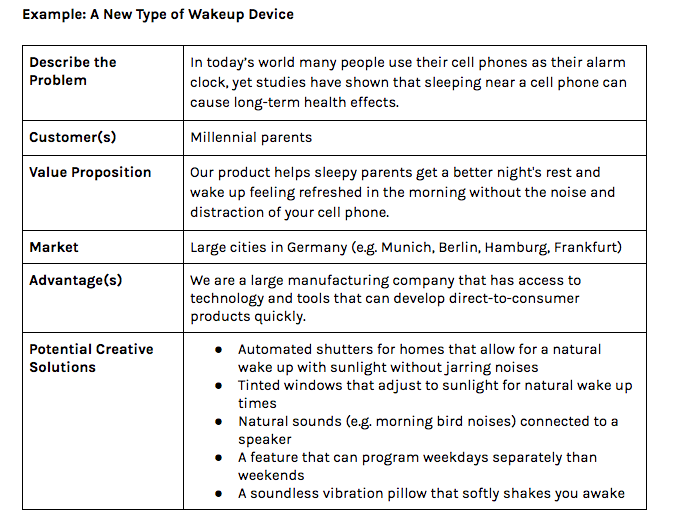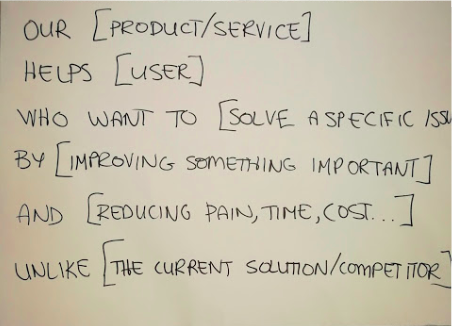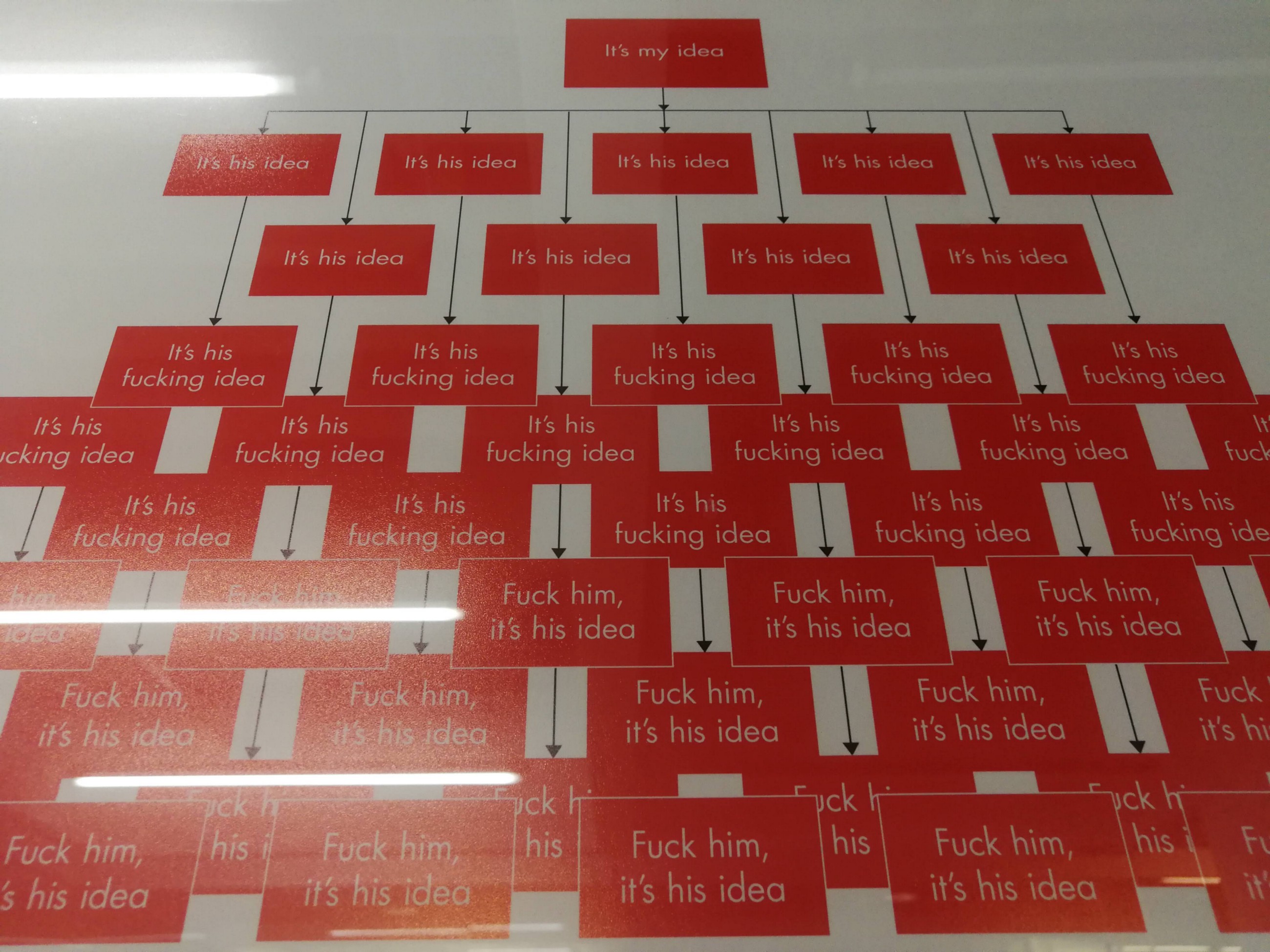Published August 14, 2018 | Updated August 14, 2024 | 11 minute read
Brilliant ideas are everywhere inside of our organizations and teams. Teams who are closest to the products and services that we’re building know the work best but constantly struggle to get their great ideas in front of leadership. In everyday change and on agile teams, small ideas can be implemented quickly as teams learn and improve products and services. It’s getting those nuanced, big, crazy ideas out there that can be tricky.
Teams say things like, “I just don’t have enough time to do the research to prepare my idea for my manager” or “I have no idea the first step to getting my thoughts organized to share.” In this article, I’m going to share six steps that can help you get your idea organized quickly to share your pitch with leadership. If you are leadership, this can be a starting template to encourage your team to share bold ideas:
- Step 1: Identify the Problem
- Step 2: Identify Potential Customer Segment(s)
- Step 3: Consider the Value Proposition
- Step 4: Define the Market
- Step 5: State the Advantage
- Step 6: Share Potential Creative Solutions
To break down each step, I’ll share a real idea from a client team member who asked me for help. Her idea was an app that you could connect to your window shutters to open at a specific hour to wake you up naturally with sunlight. We broke down the idea using this simple template.

In more detail below, I’ll share with you how we were able to articlulate each point clearly and present this to stakeholders.
Step 1: Identify the Problem
I often see great ideas start with the solution: a new app, a peer-sharing business model, a cloud-based software, etc. Having an idea for really great technology, product or service is great, but if it is not solving a problem or solving the needs of a group of people, it might not be the right time to work on the idea. If you have a great solution, start by asking yourself “what’s the problem I’m trying to solve?”
In our example, we had a great potential solution, but what problem was this going to solve? People have access to all types of alarm clocks, radio clocks, watch alarms, and cell phones. So I probed her with a series of “why’s” to understand the root of the problem (this approach comes from the 5 Why’s Exercise from lean manufacturing).
Camille: I think auto-opening shades could be a cool, more natural way to wake up instead of alarm clocks.
Me: Why do you want the shades instead of an alarm?
Camille: Alarms are loud and jarring to wake up to.
Me: Why not wake up to music instead?
Camille: The only way to wake up to music is if I use my phone.
Me: Why not use your phone as your alarm clock that can wake you up to music?
Camille: Ugh! My husband and I are trying to do this thing where we don’t sleep in the same room as our phones, we are too “connected” all of the time.
Me: Why does that bother you?
Camille: I keep reading things about sleeping with your phone can be detrimental to your health and I want to stay healthy to be here for my kids.
Ah! The root cause is sleeping with the phone somewhere near her and her husband to wake her up. In this case the problem is: In today’s world many people use their cell phones as their alarm clock, yet studies have shown that sleeping near a cell phone can cause long-term health effects.
When you read this problem statement, you notice that there could be hundreds different creative solutions to this problem once she’s able to start talking to potential customers. In this case, Camille has an idea or a hypothesis that her idea is the right solution.
Step 2: Identify Potential Customer Segments
When it comes to identifying your customer segments starting with “everyone, because my product will be so amazing everyone will want to use it,” might be a smidge ambitious, but it shouldn’t require months of marketing research either. Identifying who your customer segment might be doesn’t have to be a science, it just requires a little bit of empathy mapping or putting yourself in the users shoes. What is the user thinking and feeling, what are their pain points, is this truly a problem for users, what else motivates or frustrates this type of user? Take a bit of time to answer or brainstorm these questions with a friend or co-worker and see what you come up with.
For our problem, we decided that Millennials parents are probably our target user. They’re thinking about their long term health for themselves and their kids. They’re probably less “on-the-go” and don’t require their cell phones as an alarm like say, regular travelers. They’re feeling like it is important to set a good example of a healthy balance of technology for their children.
Step 3: Consider the Value Proposition
A value proposition is, again, a hypothesis that needs to be tested and validated with real potential customers once you are able to get your idea off the ground. For now, it’s your best guess at what you think your product or service will do to benenfit the customer. There are many different templates that can help you generate a your first version of a value proposition. Here is one that I like to use as a first start with teams:

If you can’t make out my mid-workshop handwriting, it reads: Our [product or service] helps [users/customers] who want to [solve a specific issue] by [improving something important] and [reducing pain, time cost, etc…] unlike [the current solution or competitor]. Using this structure, you can ideate through each piece of the phrase, eliminate what doesn’t apply to your idea, or add different elements if your idea is very unique. Again this is a starting point and should remain open to continuous iteration.
After a few iterations on our own, in our example, we landed on something we hoped to be simple to understand: Our product helps sleepy parents get a better night’s rest and wake up feeling refreshed in the morning without the noise and distraction of a cell phone. In this example, we don’t have a fully baked product or service yet, just our hypotheses. So we left out anything about shutters, automation, or an app for now.
Step 4: Define the Market
Defining the market is something that will evolve over time. Your target market can be as broad as Facebook (all 6B people in the world) or as narrow as a luxury brand (targeting a very elite market). Your idea will likely fall somewhere between these two extremes, so consider your target customers/users and think about where you might find them.
At this stage of your idea, think of the “market” as who you think you can start to test and validate you assumptions with in the next few weeks or month. In our example, the entire human population might not be the place to start since so many types living structures have so many different architectures and types of windows. Also, we’re not quite sure how much of a problem this is for people outside of our circles just yet. We knew it would also be easy, and cost very little, to talk to parents in our surrounding communities. For our example, we landed on large cities in Germany (e.g. Munich, Berlin, Hamburg, Frankfurt) as our starting markets.
Step 5: State Your Advantage(s)
When teams or individuals are presenting new ideas to stakeholders inside of their organizations, leadership can be resistant to invest in or take on ideas that fall into the “disruptive” category— A type of innovation that is outside the core business, introduces a new market, new technology, or new customer (for a better understanding of types of innovation, check out this article I wrote).
I have seen teams get slammed with this question over and over again: “Why us?” In other words, why is this idea at all something that our company should be doing, and why should we invest in this idea?
To bring stakeholders along, preempt this question by giving examples of how your organization indeed does have an advantage to solving the problem and how it can be beneficial to the future of the business. Again, this is going to be based on a heaping pile of assumptions, but it’s critical to really know the motivations of your stakeholders. It’s always a good idea take a look at how your idea relates back to your organizations goals, strategic initiatives or other long terms initiatives.
In our example, our advantage is that we are a large manufacturing company that has access to technology and tools that can develop direct-to-consumer products quickly. Without getting more specific, and giving away my client, you can imagine that inside your organization, you can be a lot more specific in your approach to answering this question.
Step 6: Share Potential Creative Solutions
Last step! Sharing potential solutions. When Camille came to me with her idea, it was framed as the solution to the problem. Once we were able to get to the root problem, we realized, hey! there are lots of different possibilities of solving this problem!
So we did a quick exercise that I like to call “hack your idea” something I came up with as a really easy workshop type where you can generate multiple ideas by enlisting folks not embedded into the research that can help you ideate quickly.
A quick version of this workshop is really simple (and I would encourage you to do this on any type of new idea) is ask a few colleages for 10–15 minutes of their time. First pitch your idea and share all of the work you’ve done so far to shape your idea and ask them to “hack” it. Grab some post-its, a timer, and giver you teammates a few prompts to help you shape some creative hypotheses to a solution to your problem. Set a timer for 3 minutes, ask your teammates to generate as many ideas as they can think of and then share.
In less than 15 minutes Camille and I had some bold ideas from our colleages: Tinted windows that adjust to sunlight for wake up times, natural sounds connected to a speaker to wake up (e.g. morning bird sounds), a feature that can program weekdays differently than weekends, a soundless vibration pillow that softly shakes you awake… the list continued. One or none of these solutions could be “the one” but it demonstrates leadership that your idea will change based on what you learn when you start talking to customers.
I would encourage anyone with a great idea to get started! Sharing your idea shouldn’t take more than an hour or two to pull together. In fact, you’ve probably spent more time noodling on your idea for a while but never had the opportunity to write it down or share it.
Sharing your idea doesn’t need to come with a huge ask for budget, time or resources. If you are able to ask for that, go for it! If you are just asking for some creative time in your day or week with a few others, ask for that. Your pitch, however, should always remain focused on your very next step: Validating your assumptions and hypotheses with real potential customers/users. The sooner you realize your problem exists (or doesn’t), the better you will be able to design a product or service that works.
Have you tried other methods? Are you pitching ideas on your team, how so? I’d love to hear from you. Connect with me at www.krysburnette.com









